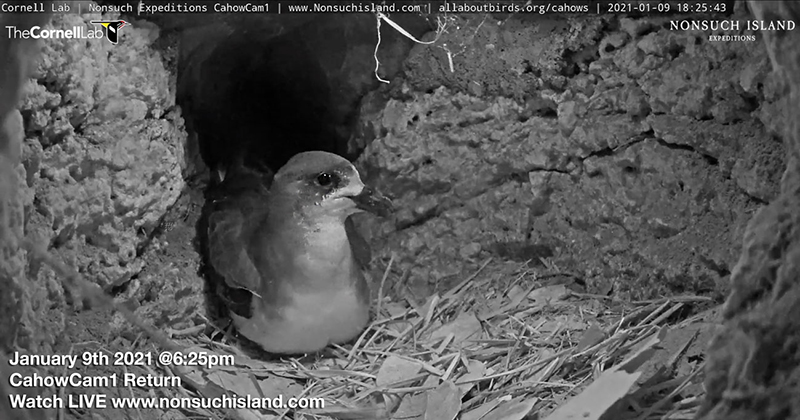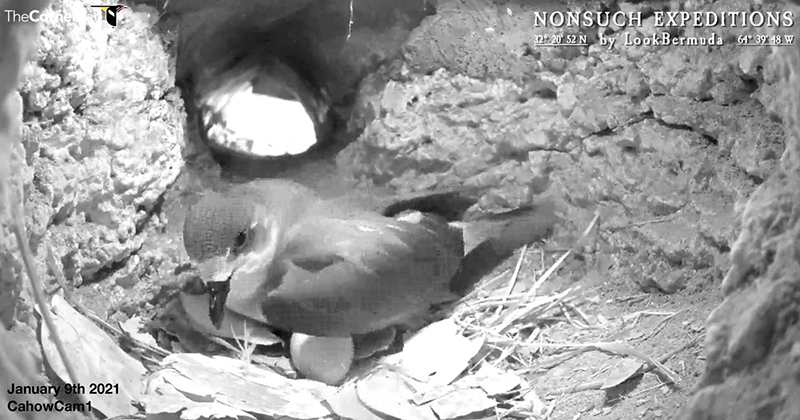Video: CahowCam Pair Return And Lay Egg
The island is set to welcome a new resident soon, as a Cahow on Nonsuch Island laid an egg, with the pair of birds managing to coordinate their return for the occasion despite being apart at sea for two months.
Jean-Pierre Rouja, Nonsuch Expeditions Founder and Team Leader said, “As our followers from around the world watched live, the male from the underground CahowCam 1 burrow — one of which we have been live streaming for the past 9 years — returned at 6:25pm.
“Amazingly, despite having been apart, at sea, for over 2 months he was able to coordinate with his mate which arrived less than 4 hours later at 10:20pm.
“As Jeremy had predicted the day before, she then laid her single egg within the hour, revealing it to our online viewers by 11:24pm
“They spent the next few hours preening and adjusting the nest before she left at 3:24 am, leaving her mate alone to incubate the egg for the first weeks whilst she recuperates at sea.
“If all goes well the egg should hatch around the beginning of March, followed by 3 months of feeding trips, which can cover hundreds to thousands of miles as the parents seek out cold water fish, shrimp and squid north of the Gulf Stream.
“All of this and more can be watched live via www.nonsuchisland.com where users can sign up for our newsletter and educational materials.”
Photos courtesy of Nonsuch Expeditions:
In providing a general update, Jeremy Madeiros, Principle Scientist – Terrestrial Conservation Dept. of Environment and Natural Resources, said, “The 2020 breeding season of Bermuda’s National Bird, the Cahow, has now kicked into high gear, as the adult birds have been returning over the last week to lay their single eggs after spending the last 5 to 6 weeks out at sea.
“The birds feed intensively during this period, enabling the females to develop an egg which can reach over 20% of her total body mass, and the males to pack on fat deposits in preparation for incubation of the egg.
“In nest checks that I carried out on Tuesday 5th January and Friday 8th January, it was determined that more than half of the Cahows in the breeding population have now returned to their nest burrows on several of the Castle Harbour Islands, the only location on Earth where the Cahow breeds.
“Measurements carried out on the returned birds show that for the second year in a row, the birds are at very healthy, near-record weights for the beginning of egg incubation, with some males recorded at over 500 grams. This indicates that they have been able to find plenty of foot items during the last month at sea, which is a good sign for the chicks when they hatch in early to mid-March.
“All signs point to a record number of breeding pairs of Cahows this year. When the Cahow was first rediscovered in 1951, after being thought extinct for over 300 years, there were only 17 to 18 nesting pairs.
“Following intensive management since 1960, and the establishment of new nesting colonies on the larger Nonsuch Island Nature Reserve, this number had increased to a record 134 nesting pairs in 2020, and indications are that the total number this year may be more than 140 pairs. This is still a tiny overall population, with the Cahow remaining one of the rarest seabird species on the planet, being listed as critically endangered.”
“This the 9th Season of LookBermuda’s Nonsuch Expeditions CahowCam project, in partnership with the Department of the Environment and Natural Resources and more recently the Cornell Lab of Ornithology with over 40 million minutes of CahowCam video being watched over that period.”
Read More About
Category: All, Environment, News, Videos





A beautiful and amazing love story!
With climate change, will they have to fly further to find the right food for their young?
It depends on the wind and shifting cold water currents in the North Atlantic where they feed, some years they find food further away and in others closer, last spring for example they had much shorter and more frequent feeding trips, so they were obviously finding food closer to Bermuda which led to heavier and healthier than average chicks throughout the colony. A bigger climate impact is sea level rise and more frequent and stronger hurricanes which when combined greatly impact the lower-lying nesting islands making the Nonsuch Translocation effort all the more important.
Soooooo adorable!!! Congrats to the Cahow parents!